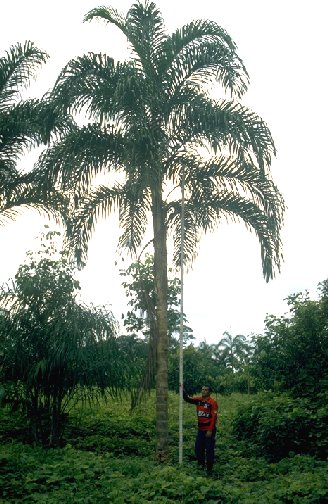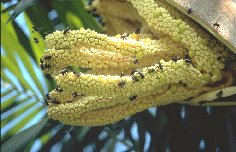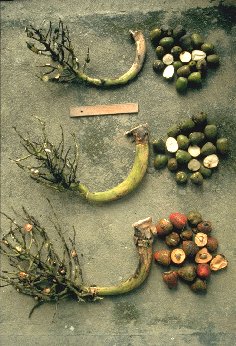


| Home (with frames) | (Last updated: 27 November 1998) |
| Back to start page | |
| Contact me |
|
References are found here
Pupunha (Bactris gasipaës Kunth, Palmae) (Fig. 1) (peach palm (Engl.), pejibaye, pijuayo, chontaduro (Spanish), Pfirsich-Palme (German)) is a typical multipurpose-tree: It produces edible fruit, which is rich in starch, oil, protein, carotene (mean contents: 59.5%, 23%, 6.9%; 0-700 ppm, respectively) (Arkcoll & Aguiar 1984, quoted from Clement & Mora Urpi 1987b). Pupunha is also managed to harvest its palm-heart (port. palmito). The fruit (stone fruit, some seedless, see Fig. 1) is used raw as vegetable, or is boiled, roasted or canned. It can also be dried to chips or ground to flower, be used to produce oil, used as valuable animal ration or can be used in other ways (Mora Urpi et al. 1984). By beginning of 1996 local price at the market of Manaus was about 4$/kg of a multiple fruit. The palm-heart is canned and sold nationally and internationally as topping for pizza and for salads. Local market prices for glassed palm-heart were as high as 8$/500g (both prices are taken from Schmidt 1996). |
|
|


|
|
Fig. 1 Big pupunha (fruit) tree of four years age growing in the SHIFT-Experiment (left), pupunha (palm-heart) offshoots consisting of a bundle of several offshoots (left photo, to the left of the pupunha (fruit) tree). The photos to the right show the inflorescence with lots of small wild bees pollinating the flowers (top) and the fruit of pupunha (bottom). The fruit of the plants of the SHIFT-Experiment varied in color from green to red, with white to apricot color of the fruitflesh. The ruler shown has a length of 21 cm. Note, that only one of the fruit bundles has fruit with seeds. Data of the chemical analysis of the fruit and of the seeds is listed in the annex. |
|
First inflorescence is formed after about three to four years (Ferreira 1991). The trees of the SHIFT-Experiment started to produce fruit after the fourth year onwards. The flowers (thousands of male flowers and hundreds of female flowers for each of several simultaneous inflorescences are genetically self-infertility but smaller seedless fruit may form despite of (Mora Urpi et al. 1984). Yield reported is from 11 t/ha fresh fruit (Johannessen 1967) in Costa Rica without modern agriculture to 25 to 30 t/ha fresh fruit by the use of improved agricultural practices (Mora Urpi 1979; average yield on small farms in Amazônia was estimated to 6 to 10 t/ha fresh fruit (Clement & Mora Urpi 1987b). This is much more than for rice or corn or beans (or equal to cassava) under similar conditions considering the starch content of the crops. Also the high content in protein speaks in favor of pupunha. Yields are expected to be even higher after selection of germplasm. Therefore pupunha could be a viable alternative to common cultivation of rice, corn or beans (Clement & Mora Urpi 1987b). The leaves of the pupunha palm can be used as green fodder for stock and the timber can be used for may special purposes; it is highly strong and flexible (Nurminen 1994, taken from Schmidt 1996). Palm wine can be produced and in former times Indians used the wood to construct bows and arrows and the roots as a medicine against intestinal worms (Clement 1987a). Pupunha is strongly affected by weed competition, especially grasses (Mora Urpi et al. 1984). Mora Urpi et al. (1984) describe known pests and diseases of Pupunha. Clement & Mora Urpi (1987b) and Mora Urpi et al. (1984) report that pupunha responds well to fertilization. For pupunha (fruit) cropped on an Ultisol Perez et al. (1987) (quoted from Benites 1990) found good fertilizer response to N and to a lower degree to K, but not to P, lime, and Mg. Pupunha reaches up to about 25 m in height with stem diameters typically between 10 and 30 cm (Ferreira 1991). Stem and petiole of most progenesis show many long spines. Few spine-less varieties exist. From hidden shoot apexes pupunha regularly forms several offshoots, locally known as "perfilhos". These grow in height as does the main stem forming a clump of plants with probably separate root systems. From this regeneration the possibility derives to harvest the palm-heart - for which the shoots are cut about once each year- without killing the plant. Propagation is mainly done by seeds (about one and a half to four month for germination depending on method) as planting shoots cut from the main plant is not as successful. Pupunha has been cultivated by the Indians since pre-Columbian times with a distribution from Hinduras - 17oN - to Bolivia - 17oS (Mora Urpi et al. 1984). In the long history of domestication, lots of varieties have been selected. The one planted in the SHIFT-Experiment is a spine-less variety and thought to be closely related to the Yurimaguas variety from Peru which is cultivated at INPA (Manaus). From the average fruit fresh weight of about 30 g (including the seed) from one tree of our experiment the progenesis is thought to be rather one of the spineless "Mesocarpa" (Ferreira 1991, referring to Mora Urpi & Clement 1985). Nevertheless variation within the varieties is high (Mora Urpi et al. 1984). Since the large majority did not produce ripe fruit until mid of 1996 it is unclear which variety was planted. See further reports on SHIFT Manaus for information. The period of harvest is similar to that of cupuaçu: from November/December to about June, but with a strong variation (depending on weather) from year to year. As for cupuaçu, the fruits of pupunha need about 4 month to ripe, but in contrast the ripening fruit may remain at the plant for one to two month before it has to harvested. After harvest the fruit stores badly. Pupunha is well adapted to acid soils being poor in nutrients (Mora Urpi et al. 1984). Although originated in forests the species favors full sun; during the early stage of development it benefits from shading (Mora Urpi et al. 1984). Climatic conditions are temperatures in the range of 24 to 28oC and rainfall between 1900 and 6000 mm/year (Ferreira 1991, referring to Mora Urpi et al. 1982). Pupunha is sensitive to poorly drained soils (Mora Urpi et al. 1984). It can be concluded from leaf shedding during the dry season 1996 in the present experiment, that pupunha is also sensitive to slight drought. This is supported by Sanchez (1981) who reports that drought reduced the number of living leaves. Mora Urpi et al. (1984) report a possibly reduced stem diameter in regions with pronounced dry season. He states a life span for a single leaf of about 17 month. Usually palm-heart is harvested from wild growing palms of different species which has led to a strong locally decrease of the wild populations. The fruits of these palms are a main food source for lots off different species of parrots and toucans. Growth pattern of pupunha is the Tomlinson-Model (Halle et al. 1978), typical for many palms. Regarding allometry the lack of secondary stem thickening and of secondary branching or splitting up of the stem is of mayor importance. Also the irregular shape of the cross section of the petiole, which is largely the functional equivalent to branches in dicotyledonous species, affects allometric proceedings; a true cross-sectional area of the petiole can not be calculated. The shedding of leaves during the dry seasons, which was observed in 1996 for our plants, affects allometrics in a way, that several allometric relationships developed by Szott et al. (1993b) can not be applied here. |
WOLF, M.-A. (1997). Accumulation of biomass and nutrients in the aboveground organs of four local tree species in monoculture and polyculture systems in central Amazonia. German "Diplom"-thesis [unpubl.]. Technische Universität Braunschweig.
e-mail ([email protected])